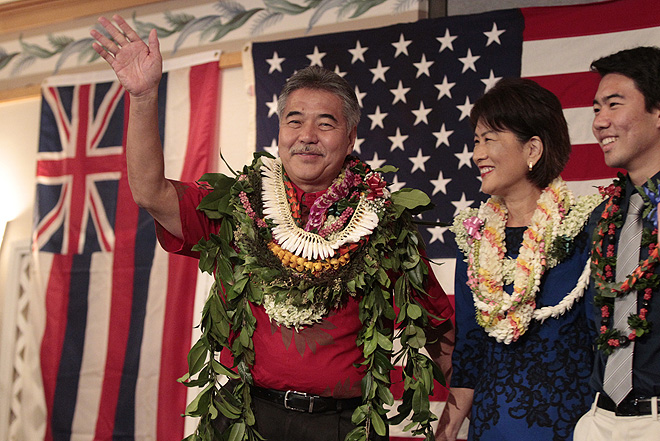David Ige fell just short of a majority in the governor’s race on Tuesday, but the Democrat’s victory was based on geographic dominance across Hawaii.
The former state senator defeated former Lt. Gov. James "Duke" Aiona, the Republican, 49 percent to 37 percent, with former Honolulu Mayor Mufi Hannemann, the Independent Party candidate, trailing at 12 percent.
The governor-elect claimed 44 of the state’s 51 House districts, a Honolulu Star-Advertiser analysis shows, taking the neighbor islands and all but portions of the west side, North Shore and Windward Oahu.
Ige said he was committed to running a positive campaign and struggled over how to respond to negative advertisements by Republicans in the closing days before the vote. While private and public polls gave him a consistent lead, he said his campaign did not have tracking polls at the end.
"It’s always hard to get a sense of how successful you are or you aren’t," Ige said. "So we just kept focused on the get-out-the-vote message."
Keith Hiraoka, Ige’s campaign manager, said the strategy was "to be inclusive of all of the islands," adding, "Sen. Ige traveled extensively during the campaign because we did not want anyone in the neighbor islands to feel that it was a race for governor of the state of Oahu. And I think it worked."
Ige broke the majority threshold on Hawaii island, Maui and Kauai, which have trended solidly blue in recent elections. But the race was closer on Oahu, the state’s population center, where Ige led Aiona 48 percent to 40 percent.
Ige did well in traditionally Democratic districts, swing districts, and in most Republican districts. The territory he dropped on the west side and on the North Shore and Windward Oahu, however, included two Republican districts and one — House District 43 on the Waianae Coast — that flipped on Tuesday when Andria Tupola, a young Republican music educator, ousted state Rep. Karen Awana, a Democrat who had run afoul of state campaign-finance law.
The territory also included Aiona’s home in Kapolei and neighborhoods with a higher proportion of Native Hawaiian voters. Both Aiona and Elwin Ahu, a former judge and a senior pastor at New Hope Metro, his running mate, are of Hawaiian ancestry.
New Hope Leeward, which has several thousand worshipers on the west side, also had an active voter engagement campaign.
The breakdown of the vote showed that while Aiona took more House districts than he did in his 2010 loss to Gov. Neil Abercrombie — when he won only his home district in Kapolei — both his share of the vote, and his raw vote total, declined from four years ago.
Aiona received 40 percent of the vote in 2010, or 157,311 votes. The Republican got 37 percent on Tuesday, or 135,742, a decline of 21,569 votes.
In addition to the record low voter turnout of 52.3 percent, political strategists contend Aiona shed some votes to Hannemann, although polls suggest that the former Honolulu mayor drew more from Ige, keeping Ige from a majority.
While a Republican wave nationally helped the GOP take control of the U.S. Senate and expand a majority in the U.S. House, the results in traditionally Democratic Hawaii were not encouraging for the party. Tupola’s victory gave Republicans one additional seat in the state House — for eight out of 51 — while Democrats preserved their 24 to 1 lock on the state Senate.
Blake Parsons, the executive director of the Hawaii Republican Party, said the party should have focused on voter identification and its get-out-the-vote drive sooner. Pat Saiki, the state GOP chairwoman, had called for a refocus on the basics when she took over the party in March.
"There was a low turnout. I think there was a lot of apathy out there," Parsons said. "There’s still people who don’t feel like there is an opportunity, but that’s where the Republicans have to do a better job" of showcasing candidates.
data.staradvertiser.com/precinctmap
Star-Advertiser data news editor Dana Williams contributed to this report.

ENLARGE CHART


